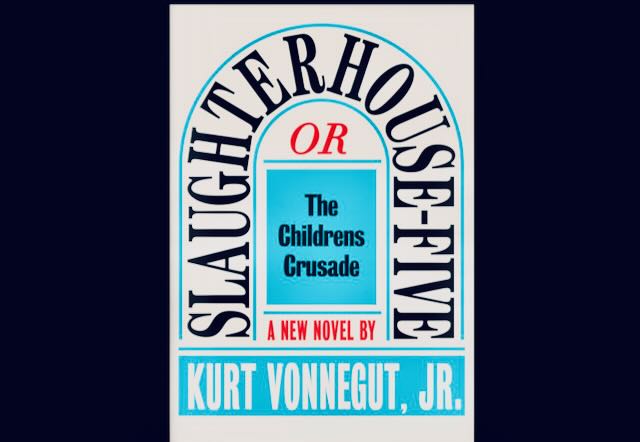On the title page of Kurt Vonnegut’s modern classic Slaughterhouse-Five, or The Children’s Crusade, Vonnegut remarks that the novel is “somewhat in the telegraphic schizophrenic manner of tales of the planet Tralfamadore.” This means nothing to you as you read the title page, but as you get into the book and it strikes you how there seems to be no clear cause and effect plot going on, or even a plot that follows a typical timeline, but rather it seems a collection of random moments from the life of Billy Pilgrim that progress, if that’s the word, from one moment to another with no particular connection as Billy, who has become “unstuck in time,” moves between 1945 to 1955 to 1948 to 1968, and between Dresden, Germany to New York to his hometown of Ilium to the planet Tralfamadore, and back again. On Tralfamadore, Billy asks why Tralfamadorian books are laid out as if they were a series of telegrams. He is told:
each clump of symbols is a brief, urgent message –describing a situation, a scene. We Tralfamadorians read them all at once…. There isn’t any particular relationship between all the messages, except that the author has chosen them carefully, so that, when seen all at once, they produce an image of life…. There is no beginning, no middle, no end, no suspense, no moral, no causes, no effects. What we love in our books are the depths of many marvelous moments seen all at one time.
Vonnegut’s post-modern novel does precisely this. And the structure underscores one of the central themes of the book: that we have no real control over what happens to us or to anyone else. When Billy looks at the AA prayer posted on his wall—“God grant me the serenity to accept the things I cannot change, courage to change the things I can, and wisdom always to tell the difference”—we are told that “Among the things Billy Pilgrim could not change were the past, the present, and the future.”
So there’s an irony in Vonnegut’s writing an anti-war book, which is the first thing anybody says about Slaughterhouse-Five. The first sentence in the Wikipedia article on the book, for instance, identifies it as “ a 1969 semi-autobiographic science fiction-infused anti-war novel.” But in the first chapter of his novel, when Vonnegut is discussing his process of working himself up to write about his experiences in Dresden in the last months of World War II, one friend tells him “Why don’t you write an anti-glacier book instead?” Global warming has taken much of the sting out of that retort, but the point is that war will always be, as long as there are people, and we have as much chance of eliminating them as of stopping the advance of a glacier.
Still, Vonnegut’s novel hit at just the right time, in 1969 when huge numbers of young people were trying to stop the U.S. War in Vietnam. But it was not only the Woodstock generation that revered this novel. It has retained its popularity and its critical appeal in the 55 years since its publication. In 1998, the Modern Library ranked Slaughterhouse-Five as number 18 on its list of the 100 greatest novels of the century. Time included it on its list of the greatest English-language novels since 1923. Literary Hub included it as number 4 on its list “Quintessential American Fiction, According to the Rest of the World.” It was 14th on the Library Journal’s “Books of the Century,” and 19th on NPRs list of “Top 100 Science-Fiction, Fantasy Books.” On the “Greatest Books of All time” website, Vonnegut’s novel appears as 34th among English language novels. And on and on. And of course, it appears here as book number 90 (alphabetically) on my own list of the “100 Most Lovable Novels in the English Language.”
Vonnegut begins by identifying himself as the book’s narrator: a man still dealing with the trauma of his experiences as prisoner of war housed in a Dresden slaughterhouse in the last year of the war in Europe. Obsessed with having witnessed the allied firebombing that destroyed that city and digging in the wreckage to find the dead, he visits his wartime friend Bernard V. O’Hare to talk over their experiences and gather memories for his book. Bernard’s wife chafes at the idea of a war novel, griping that the movie will star John Wayne or Frank Sinatra and make the war look romantic and glorious when in fact as soldiers they were “just babies,” and novels like this one will simply encourage more wars, in which her own “babies upstairs” will risk their lives. Vonnegut vows to her he won’t write any such thing, and in her honor promises to subtitle the book “The Children’s Crusade.” But even at the close of the first chapter, he expresses doubts about his “anti-glacier book” having any real effect. Visiting Dresden once again in 1960s, Vonnegut says he was looking for “tales of great destruction” in the Gideon Bible in his hotel room, and comes upon the story of Sodom and Gomorrah—destroyed because there were “Vile people” in those cities. But he identifies with Lot’s wife:
And Lot’s wife, of course, was told not to look back where all those people and their homes had been. But she did look back, and I love her for that, because it was so human. So she was turned into a pillar of salt. So it goes….
People aren’t supposed to look back. I’m certainly not going to do it anymore. I’ve finished my book now. The next one I write is going to be fun. This one is a failure, and had to be, since it was written by a pillar of salt.
To review the events of Billy’s life, and the novel, in chronological order, he is born in 1922 in the fictional town of Ilium, New York. He is studying at the Ilium school of optometry when he is drafted in 1944. He is supposed to be a chaplain’s assistant, but he is never even able to report for duty before he is caught up in the Battle of the Bulge. He travels through the snow with two scouts and a sadistic braggart named Roland Weary, who saves Billy’s life several times when Billy is ready to quit and tells the others to go on without him. Billy and Weary are taken prisoner, and loaded into boxcars on a train taking them to a POW camp. Weary dies of gangrene, blaming his death on Billy, and obtaining a promise from Paul Lazzaro, an equally vindictive friend he has met on the train, to avenge his death on Billy. Billy and most of the other American POWs are eventually taken as forced laborers to Dresden, where they are housed in a slaughterhouse. He survives the firebombing, but the trauma of digging for the dead—which Vonnegut estimates as 135,000 souls—is a trauma that haunts him the rest of his life.
Upon his return to the U.S. after the war, Billy has a nervous breakdown. After he recovers, he returns to optometry school, marries the unattractive daughter of the school’s founder, and becomes a successful optometrist and family man with a daughter and son back in Ilium. Just after his daughter’s wedding, aliens from the planet Tralfamadore kidnap him and take him to their planet, where he lives in a zoo with an actress named Montana Wildhack, with whom he has a child. He also learns about the true nature of time from the Tralfamadorians, and learns how to revisit any part of his life, since every moment of his life has always existed and always will. There is no real death, therefore, and when the Tralfamadorians hear of anyone dying, they simply respond “so it goes,” since it is the common fate of all and can never be avoided.
Back on earth, Billy is in a plane crash, and his wife is so rattled by his being in critical condition in the hospital that she dies of carbon monoxide poisoning as a result of a car accident on her way to see him. So it goes. Billy recovers, though. He knows how his life will end, because he has visited his death many times. I won’t reveal that part to you, though, since you may think of time in the earthling sense, and yell “spoiler.” Billy does spend the rest of his life, though, trying to get people to stop fearing death and convert to the Tralfamadorian view of things:
The most important thing I learned on Tralfamadore (Billy tells people) was that when a person dies he only appears to die. He is still very much alive in the past, so it is very silly for people to cry at his funeral. All moments, past, present and future, always have existed, always will exist. The Tralfamadorians can look at all the different moments just the way we can look at a stretch of the Rocky Mountains, for instance. They can see how permanent all the moments are, and they can look at any moment that interests them. It is just an illusion we have here on Earth that one moment follows another one, like beads on a string, and that once a moment is gone it is gone forever.
Certainly this is comforting to Billy, who believes he is spreading a reassuring message. Whether Vonnegut wants us to think this way is anyone’s guess, but it is at least a message of acceptance. Vonnegut’s real purpose is to retell the horror of his own experience as a POW during the Dresden firebombing, the terrible aftermath of searching the rubble for the endless corpses, a horror he had carried with him for 24 years before he finally told the story. Vonnegut’s estimate of 135,000 dead has since been corrected by both American and German sources to a “mere” 25,000, but it is really Vonnegut’s book that brought the bombing into public scrutiny. Dresden was a city of arts—it was of little military significance. The Germans had been shelling civilian targets in Britain throughout the war, so Dresden may have simply been “payback.” But unlike the vindictive sadist Roland Weary, Billy does not believe that revenge is the sweetest feeling in the world. Nor does Vonnegut.
How seriously the author wants us to take the alien abduction scenes is not clear. Vonnegut includes references to the little-known (because Vonnegut made him up) Sci-Fi author Kilgore Trout’s works, which seem to prefigure some of Billy’s experiences involving Tralfamadore. And there are newspaper headlines alluding to the disappearance of movie star Montana Wildhack, who is feared drowned. Clearly Vonnegut leaves the possibility open that the abduction and subsequent time in an alien zoo are simply the delusions of a mind seriously traumatized, whose PTSD has been reawakened by the near fatal plane crash, which killed everyone on board except Billy and the copilot. So it goes. More importantly, Vonnegut’s story has been a well-loved anti-glacier novel for well over 50 years, and shows no sign of diminishing. It is, after all, easy to read—the language and style are simple, a la Hemingway, and it is only 215 pages long. Of course, it has been banned and challenged in schools for 50 years as well, including a famous incident in North Dakota in the 70s when copies were burned along with books by Hemingway, Faulkner, and Steinbeck. But such reactions tend to make more people interested in reading such books, so let the heathen rage.
I should mention in closing that there is a 1972 film version of Slaughterhouse–Five directed by George Roy Hill, which is worth watching. It was a box office flop, but won the Jury Prize at the Cannes Film Festival that year. The film also won a Hugo Award and a Saturn Award. And Vonnegut himself loved it. But that doesn’t mean you should watch it instead of reading the book.

